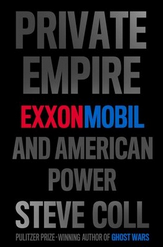 Two of Alaska’s three major oil and gas producers are highly visible, but the third one is not. While BP and Conoco Phillips have large office buildings in Anchorage, Exxon-Mobil’s Alaska operations are run from an anonymous suite of offices in a mid-town building that has no sign bearing the company’s name. The sign was taken down 23 years ago for security reasons when protests erupted there following the Exxon Valdez oil spill. It was never replaced.
Two of Alaska’s three major oil and gas producers are highly visible, but the third one is not. While BP and Conoco Phillips have large office buildings in Anchorage, Exxon-Mobil’s Alaska operations are run from an anonymous suite of offices in a mid-town building that has no sign bearing the company’s name. The sign was taken down 23 years ago for security reasons when protests erupted there following the Exxon Valdez oil spill. It was never replaced.
The author of a new book about the company does not find that surprising at all. “New Yorker” writer Steve Coll says the corporate culture within Exxon-Mobil is all about minimizing risk and steadily making money. The book “Private Empire: Exxon-Mobil and American Power” opens with an account of the Alaska oil spill, which made the company the most hated in the nation, but, Coll says, also one of the most safety-oriented.
Coll paints a portrait of a company in which everything is done by the book and everybody plays by the same rules – a regimented company in which control is paramount. And he says that control mania is probably why Exxon-Mobil has been reluctant to do business in Alaska.
Coll says even though Exxon-Mobil’s current chairman, Rex Tillerson, is cut from pretty much the same cloth as his predecessor, Lee Raymond, the company has begun to change. It no longer opposes a carbon tax, for instance, as a way to deal with climate warming. Also under Tillerson, Exxon is increasingly emphasizing natural gas as well as crude oil. Gas accounts for about half of its recoverable reserves.
At the end of March, the company was able to add substantially to its gas reserves, when it quietly bought out Chevron’s 25 percent share of the un-developed Point Thomson field on the North Slope. Two days after closing that deal, Exxon-Mobil settled a long-running dispute with the State of Alaska over whether its development plan for Point Thomson was moving ahead fast enough to prevent the state from taking the leases back. Exxon-Mobil can now add 200 million barrels of natural gas condensate to its reserves – liquids it hopes to produce. It can also add eight trillion cubic feet of gas that may get to market sometime in the future. Coll’s book is full of examples of how important it is to Exxon-Mobil to be able to book new reserves to replace what it produces, but he says it’s questionable whether Point Thomson should count.
The Point Thomson gas is still considered stranded, because there is no pipeline to deliver it to market, but the fact that it is there and ready to be developed makes a big gas line a more attractive investment. Steve Coll appeared on the public radio call-in show “Talk of Alaska” Tuesday morning.
Listen for the full story
sheimel (at) alaskapublic (dot) org | 907.550.8454 | About Steve




